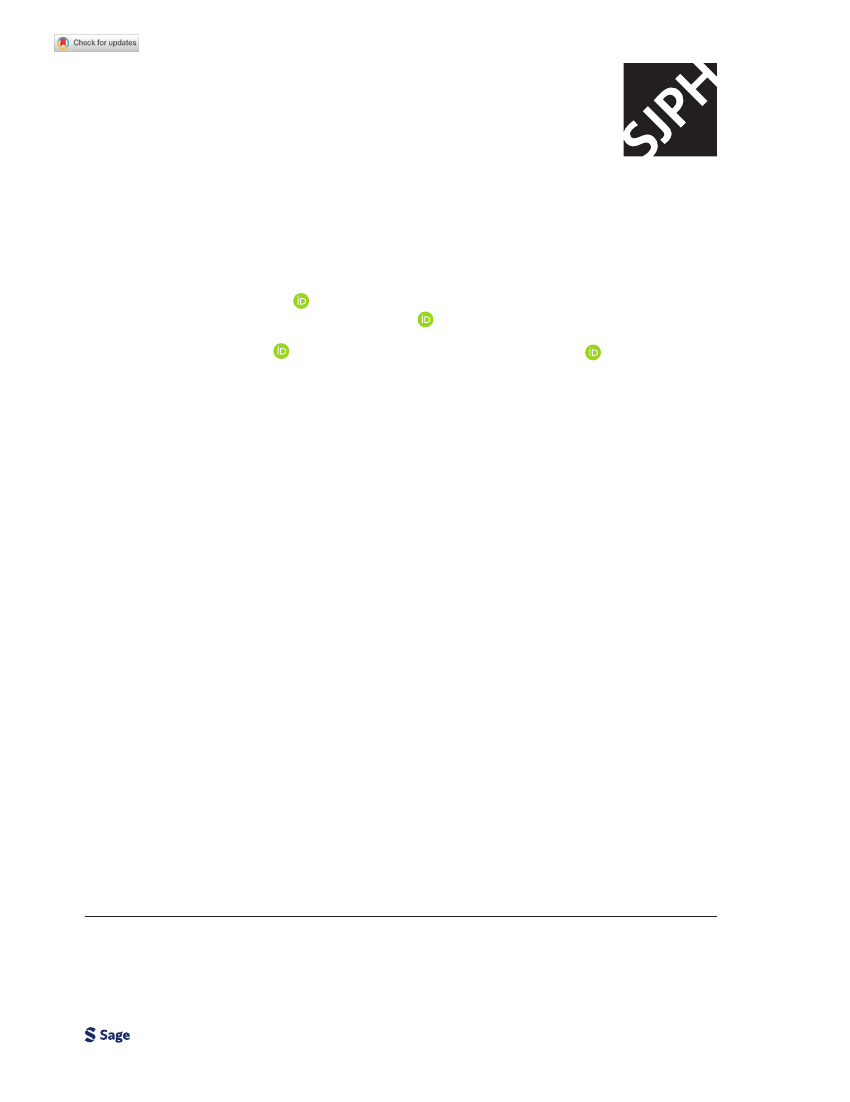
1228158
research-article2024
sjP0010.1177/14034948241228158M.B.D. Nielsen et al.Two Methods for Assessing Workplace sexual and Gender-based harassment
Beskæftigelsesudvalget 2023-24
BEU Alm.del - Bilag 127
Offentligt
Scandinavian Journal of Public Health,
1–8
OriginAl ArTicle
Workplace sexual and gender-based harassment in Denmark: a
comparison of the self-labelling and behavioural list method
MAj BrITT DAhl NIelseN
1
, AlBerTe BOukAIDI ANDerseN
2
,
Gry GruNDTvIG
3
, kAThrINe søreNseN
2,4
, jOsefINe rANfelT ANDerseN
1
,
NANNA P. lArssON
2
, sOfIe sMeDeGAArD skOv
1
,
ANNA PAlDAM fOlker
1
, susIe kjær
5
, Per TyBjerG AlDrIch
6
,
reINer ruGulIes
2,7
, ThOMAs clAuseN
2
& IDA e. h. MADseN
1,2
National Institute of Public Health, University of Southern Denmark, Copenhagen, Denmark,
2
The National Research
Centre for the Working Environment, Copenhagen, Denmark,
3
COWI, Lyngby, Denmark,
4
Department of Psychology,
University of Copenhagen, Copenhagen, Denmark,
5
Anerkendende Psykologpraksis, Herlev, Denmark,
6
BUPL Copenhagen
Ø, Denmark,
7
Section of Epidemiology, Department of Public Health, University of Copenhagen, Copenhagen, Denmark
1
The
Abstract
Aim:
knowledge about the prevalence of sexual and gender-based harassment is hampered by disagreements about definitions
and measurement methods. The two most common measurement methods are the self-labelling (a single question about
exposure to sexual harassment) and the behavioural list method (an inventory of sexually harassing behaviours). The aim of
this paper was to compare the self-labelling and the behavioural list methods for measuring sexual harassment and assess the
association with depressive symptoms.
Methods:
The study is based on a convenience sample of 1686 individuals employed in
29 workplaces in Denmark. survey data were collected from November 2020 until june 2021 and there were 1000 participants
with full data on key variables. We used a linear mixed-effects model to examine the relationship between sexual harassment
and depressive symptoms.
Results:
In total, 2.5% self-labelled as being sexually harassed, while 19.0% reported exposure to at
least one type of sexual and gender-based harassment using the behavioural list method. Both groups reported higher levels
of depressive symptoms compared with non-exposed employees. The most common types of behaviours were: that someone
spoke derogatorily about women/men (11.6%); being belittled because of one’s gender or sexuality (4.7%); and unwanted
comments about one’s body, clothes or lifestyle (4.5%).
Conclusions:
The behavioural list method yielded a higher
prevalence of sexual and gender-based harassment compared with the self-labelling method. Self-labelling and
reporting at least one type of sexual and gender-based harassment was associated with depressive symptoms.
Keywords:
sexual harassment, self-labelling, survey, prevalence, depressive symptoms
Background
Workplace sexual harassment is associated with
depression, anxiety, post-traumatic stress disorder
and suicide[1-7]. There is no universally accepted
definition, but most highlight that it is unwanted and
harms the victim and/or contributes to a hostile
working environment [2,8-10]. One of the most
widely used conceptual frameworks is the Tripartite
Model [2] that defines sexual harassment as three
distinct, but interrelated phenomena: unwanted sex-
ual attention; coercion; and gender harassment.
Unwanted sexual attention
encompasses unrecipro-
cated sexual advances,
coercion
includes job-related
pressures or bribes, for example, a promotion in
exchange for sexual favours or threats of employment
correspondence: Maj Britt Dahl Nielsen, The National Institute of Public health, university of southern Denmark, studiestræde 6, Dk-copenhagen,
1455, Denmark. e-mail: [email protected]
Date received 30 September 2022; reviewed 13 December 2023; accepted 7 January 2024
© Author(s) 2024
Article reuse guidelines: sagepub.com/journals-permissions
https://doi.org/10.1177/14034948241228158
DOI: 10.1177/14034948241228158
journals.sagepub.com/home/sjp